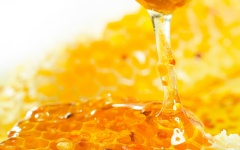Difference between revisions of "Honey"
| Line 1: | Line 1: | ||
{{Infobox_Food | {{Infobox_Food | ||
| − | | image = | + | | image = Honey.jpg |
| origin = - | | origin = - | ||
| − | | stowage factor = | + | | stowage factor = <ul><li>1,42/1,47 m<sup>3</sup>/t (cases)</li><li>1,27 m<sup>3</sup>/t (barrels |
| − | | humidity and moisture = | + | | humidity and moisture = Natural, raw honey varies from 14% to 18% in moisture content |
| oil content = - | | oil content = - | ||
| ventilation = - | | ventilation = - | ||
| − | | risk factors = | + | | risk factors = See text |
}} | }} | ||
__TOC__ | __TOC__ | ||
Revision as of 13:15, 27 June 2013
| Infobox on Honey | |
|---|---|
| Example of Honey |  |
| Facts | |
| Origin | - |
| Stowage factor (in m3/t) |
|
| Humidity / moisture | Natural, raw honey varies from 14% to 18% in moisture content |
| Oil content | - |
| Ventilation | - |
| Risk factors | See text |
Honey
Contents
Description
Liquid honey is bulked in metal drums internally lacquered to prevent adverse reaction. Leakage, leading to weight loss, results from physical damage to containers and such damage may allow entry of water, which would give rise to fermentation.
Honey proved by test to be affected by excessive heat would be down-graded for industrial use at a low price. Comb honey in domestic packs would suffer leakage by melting was at high temperatures (in excess of 50°C), but leakage by crushing of cartons and contamination of adjacent packs is the more common.
Full information on this product is in the process of completion.











